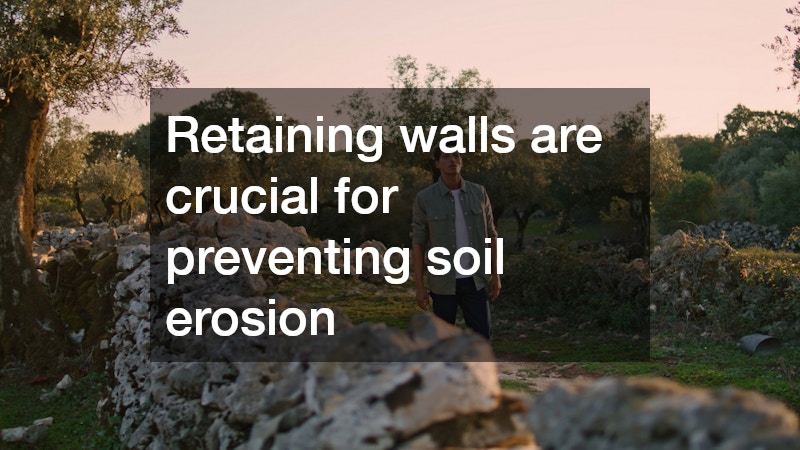A retaining wall is a critical, yet often misunderstood, feature of certain homes. Explore the various aspects of retaining walls, their purposes, and the critical role they play in maintaining safety and stability around residential properties. Learn the answers to common questions and concerns regarding retaining walls and find valuable insights into their importance for home safety.
Understanding retaining walls is crucial for homeowners, especially those living in areas with slopes or uneven terrain. These structures can drastically affect not only the aesthetics of a property but also its functionality and safety. They serve practical purposes that extend beyond mere landscaping, embedding their importance within the structural integrity of homes.
Additionally, many homeowners may not realize that an inadequate or poorly designed retaining wall can lead to significant problems. It could result in soil erosion, foundation issues, and even jeopardize the overall safety of the home.
The Function of a Retaining Wall
A retaining wall is a structure designed to hold back soil and prevent erosion, ensuring stability in areas with changes in elevation. These walls can be made from various materials, including concrete, stone, and timber, each offering different benefits based on the location and purpose.
Functionally, retaining walls work by retaining soil on one side while allowing the opposite side to remain at a different elevation. They are typically installed in gardens, slopes, and adjacent to roads where soil stability is a concern. Their design must take into account local drainage conditions and soil behavior to be effective.
Moreover, the pressure exerted by the soil behind a retaining wall increases as the height of the wall increases. This means that the taller the wall, the more robust its construction needs to be. Hence, engineering principles play a significant role in determining the design and materials used, ensuring the wall can withstand the forces acting upon it.
The Importance of Retaining Walls
Retaining walls are crucial for preventing soil erosion, protecting foundations, and managing water runoff on residential properties. By stabilizing slopes, they minimize the risk of landslides that can cause significant damage to homes and landscapes.
Furthermore, these structures aid in controlling water drainage and preventing flooding, particularly during heavy rain. Without a retaining wall, water can pool in areas that may destabilize the ground and create dangerous conditions for homeowners.
Additionally, retaining walls can enhance the usability of outdoor spaces. By leveling out uneven terrains, they can create flat areas for gardens, patios, or walkways. This practicality brings aesthetic improvements and increased property value, making them a wise investment for any homeowner.
The Types of Retaining Walls
There are various types of retaining walls, including gravity walls, cantilever walls, anchored walls, and more, each serving specific needs and conditions. Gravity walls rely on their weight to resist the pressure of the soil behind them, making them suitable for short walls and light loads.
Cantilever walls are designed to use leverage to resist soil pressure, allowing for taller constructions with less material compared to gravity walls. Anchored walls, on the other hand, utilize cables anchored into the ground to offer additional stability, effectively serving in high-pressure situations.
Each type of wall requires careful assessment of the site conditions, such as soil type, slope steepness, and overall terrain, to ascertain the most appropriate design and materials. Selecting the right wall type can ultimately lead to enhanced durability and safety for the homeowner’s property.
The Impact on Safety
Properly designed and constructed retaining walls enhance home safety by stabilizing slopes and preventing landslides or soil shifts that could damage the property. This stabilization is particularly vital in regions prone to heavy rains and sliding soil conditions.
Moreover, the maintenance of a stable environment around a home protects its foundation from significant issues. A solid retaining wall can prevent water from seeping into vulnerable areas, mitigating risks associated with flooding and erosion.
In essence, the role of retaining walls extends beyond visual appeal, ensuring that the natural forces acting on the land do not compromise the safety and integrity of a home. Understanding and investing in these walls can provide homeowners with peace of mind regarding their property’s safety.
Retaining walls play a vital role in ensuring the safety and stability of residential properties. Understanding their function and importance can help homeowners make informed decisions about their construction and maintenance, leading to enhanced safety and security for their homes and families.
Investing in a well-designed retaining wall not only protects the property but also enhances its overall value and functionality. By stabilizing the landscape, they reduce the risk of water damage and soil erosion, fostering a safe living environment.
Retaining walls are more than just decorative elements; they are essential structures that contribute to the longevity and security of a home. Homeowners should prioritize understanding these systems as part of their property management strategy.




